NCERT Solutions For Class 11 Maths Chapter-6 Linear Inequalities Exercise 6.1 prepared by the expert of Physics Wallah score more with Physics Wallah NCERT Class 11 maths solutions. You can download solution of all chapters from Physics Wallah NCERT solutions of class 11.
Question 1. Solve 24x < 100, when (i) x is a natural number (ii) x is an integer
Solution :
The given inequality is 24x < 100.
Dividing both sides by 24,
⇒ 24x / 24 < 100 / 24
⇒x < 25/6
(i) It is evident that 1, 2, 3, and 4 are the only natural numbers less than 25/6.
Thus, when x is a natural number, the solutions of the given inequality are 1, 2, 3, and 4.
Hence, in this case, the solution set is {1, 2, 3, 4}.
(ii) The integers less than 25/6 are …–3, –2, –1, 0, 1, 2, 3, 4.
Thus, when x is an integer, the solutions of the given inequality are
…–3, –2, –1, 0, 1, 2, 3, 4.
Hence, in this case, the solution set is {…–3, –2, –1, 0, 1, 2, 3, 4}.
Question 2. Solve –12x > 30, when
(i) x is a natural number
(ii) x is an integer
Solution :
Given: −12x > 30.
Dividing both sides by ⇒ −12x
/
−12 < 30
/
−12
(Dividing both sides by same negative number)
⇒ x<−5 / 2.
(i) When x is a natural number then values of x that make statement true are none.
(ii) When x is an integer then values of x that make statement true are …, –5, –4, –3. The solution set of inequality is …, –5, –4, –3.
Question 3. Solve 5x– 3 < 7, when
(i) x is an integer (ii) x is a real number
Solution :
The given inequality is 5x– 3 < 7
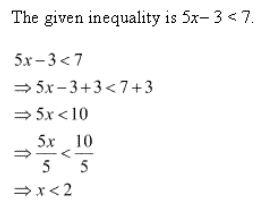
(i) The integers less than 2 are …, –4, –3, –2, –1, 0, 1.
Thus, when x is an integer, the solutions of the given inequality are
…, –4, –3, –2, –1, 0, 1.
Hence, in this case, the solution set is {…, –4, –3, –2, –1, 0, 1}.
(ii) When x is a real number, the solutions of the given inequality are given by x < 2, that is, all real numbers x which are less than 2.
Thus, the solution set of the given inequality is x ∈ (–∞, 2).
Question 4 . Solve 3x + 8 > 2, when
(i) x is an integer
(ii) x is a real number
Solution :
The given inequality is 3x + 8 > 2.
⇒ 3x + 8 - 8 > 2 - 8
⇒ 3x > - 6
⇒ 3x/ 3
> - 6/3
⇒ x
>
-2
(i) The integers greater than –2 are –1, 0, 1, 2, …
Thus, when x is an integer, the solutions of the given inequality are
–1, 0, 1, 2 …
Hence, in this case, the solution set is {–1, 0, 1, 2, …}.
(ii) When x is a real number, the solutions of the given inequality are all the real numbers, which are greater than –2.
Thus, in this case, the solution set is (– 2, ∞).
Question 5. Solve the given inequality for real x: 4x + 3 < 5x + 7
Solution :
4x + 3 < 5x + 7
⇒ 4x + 3 – 7 < 5x + 7 – 7
⇒ 4x – 4 < 5x
⇒ 4x – 4 – 4x < 5x – 4x
⇒ –4 < x
Thus, all real numbers x,which are greater than –4, are the solutions of the given inequality.
Hence, the solution set of the given inequality is (–4, ∞).
Question 6. Solve the given inequality for real x: 3x – 7 > 5x – 1
Solution :
3x – 7 > 5x – 1
⇒ 3x – 7 + 7 > 5x – 1 + 7
⇒ 3x > 5x + 6
⇒ 3x – 5x > 5x + 6 – 5x
⇒ – 2x > 6
⇒ – 2x / -2 < 6 / 2
⇒ x < -3
Therefore, the solution set is x
Question 7. Solve the given inequality for real x: 3(x – 1) ≤ 2 (x – 3)
Solution :
3(x – 1) ≤ 2(x – 3)
⇒ 3x – 3 ≤ 2x – 6
⇒ 3x – 3 + 3 ≤ 2x – 6 + 3
⇒ 3x ≤ 2x – 3
⇒ 3x – 2x ≤ 2x – 3 – 2x
⇒ x ≤ – 3
Thus, all real numbers x,which are less than or equal to –3, are the solutions of the given inequality.
Hence, the solution set of the given inequality is (–∞, –3].
Question 8. Solve the given inequality for real x: 3 (2 – x) ≥ 2 (1 – x)
Solution :
3(2 – x) ≥ 2(1 – x)
⇒ 6 – 3x ≥ 2 – 2x
⇒ 6 – 3x + 2x ≥ 2 – 2x + 2x
⇒ 6 – x ≥ 2
⇒ 6 – x – 6 ≥ 2 – 6
⇒ –x ≥ –4
⇒ x ≤ 4
Thus, all real numbers x,which are less than or equal to 4, are the solutions of the given inequality.
Hence, the solution set of the given inequality is (–∞, 4].
Question
9: Solve the given inequality for real x:

Solution :
Here

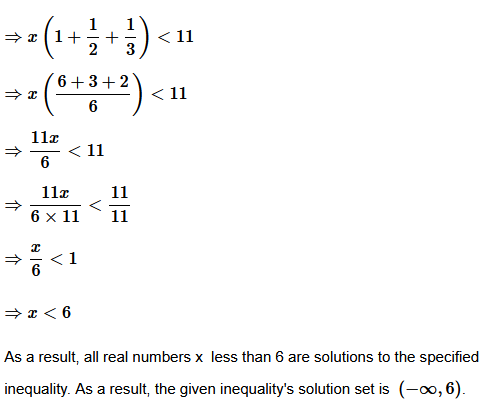
Question
10.

Solution :
Here

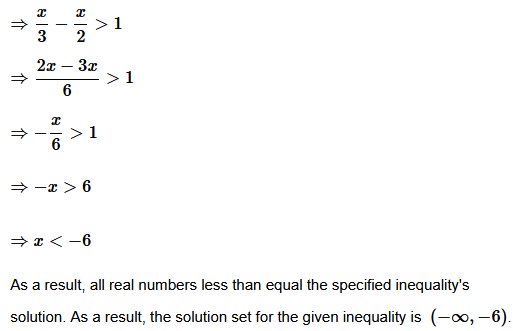
Question
11.

Solution :
given

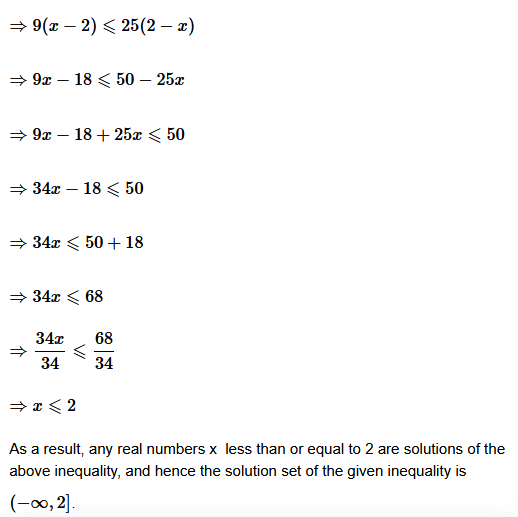
Question
12.

Solution :
Here

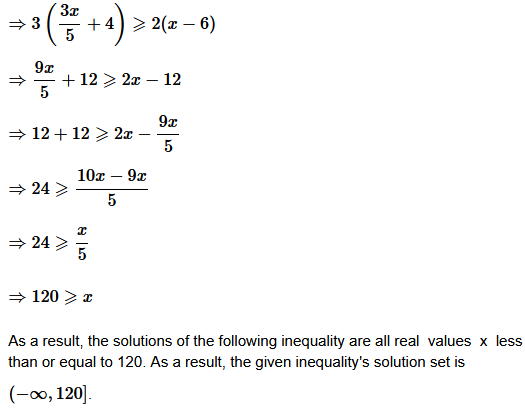
Question 13. Solve the given inequality for real x: 2(2x + 3) – 10 < 6 (x – 2)
Solution :
⇒4x+6−10<6x−12
⇒4x−4<6x−12
⇒−4+12<6x−4x
⇒8<2x
⇒4<x
As a result, any real numbers x bigger than 4 are solutions to the specified inequality. As a result, the given inequality's solution set is (4,−∞)
.
Question 14. Solve the given inequality for real x: 37 – (3x + 5) ≥ 9x – 8(x – 3)
Solution :
Here
⇒37−3x−5⩾9x−8x+24
⇒32−3x⩾x+24
⇒32−24⩾x+3x
⇒8⩾4x
⇒2⩾x
As a result, the solutions of the following inequality are all real values x less than or equal to 2. As a result, the given inequality's solution set is (−∞,2]
Question
15.

Solution :
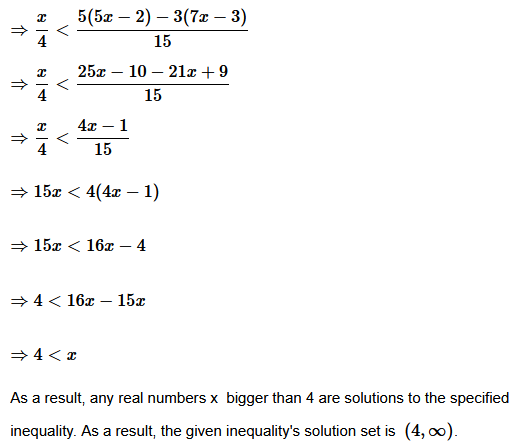
Question
16.

Solution :
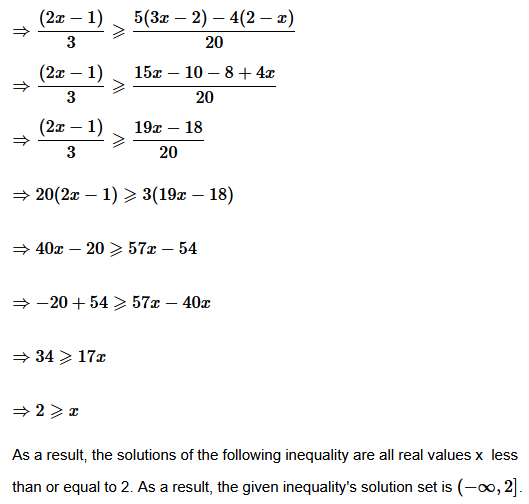
Solve the inequalities in Exercises 17 to 20 and show the graph of the solution in each case on number line:
Question 17. Solve the given inequality and show the graph of the solution on number line: 3x – 2 < 2x +1
Solution :
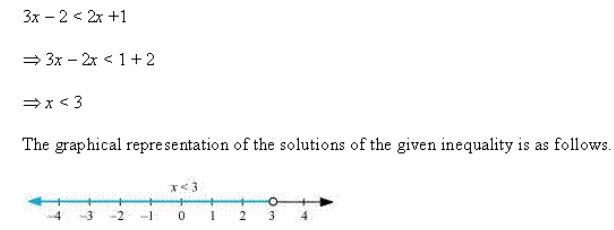
Question 18. Solve the given inequality and show the graph of the solution on number line: 5x – 3 ≥ 3x – 5
Solution :
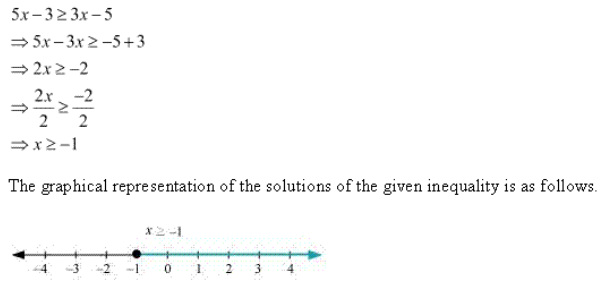
Question 19. Solve the given inequality and show the graph of the solution on number line: 3(1 – x) < 2 (x + 4)
Solution :
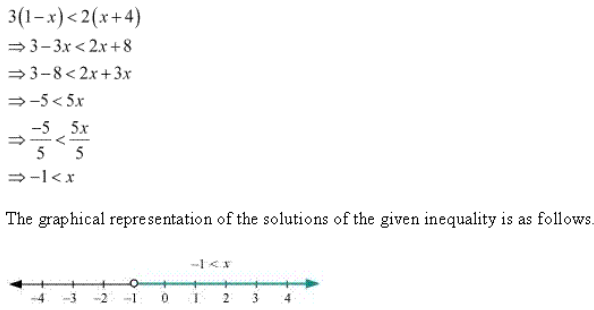
Question
20. Solve the given inequality and show the graph of the solution on number line:

Solution :
Here
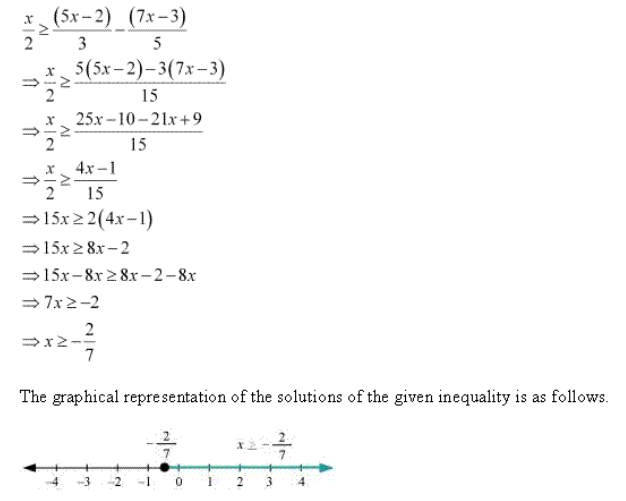
Question 21. Ravi obtained 70 and 75 marks in first two unit tests. Find the minimum marks he should get in the third test to have an average of at least 60 marks.
Solution :
Let the marks obtained by Ravi in third test be x.
According to question,

⇒145+x⩾180
⇒x⩾180−145
⇒x⩾35
As a result, the student must score at least 35 points to achieve a 60-point average.
Question 22. To receive Grade ‘A’ in a course, one must obtain an average 90 marks or more in five examinations (each of 100 marks). If Sunita’s marks in first four examinations are 87, 92, 94 and 95, find minimum marks that Sunita must obtain in fifth examination to get Grade ‘A’ in the course.
Solution : Let x represent Sunita's grade in the fifth examination. She must receive an average of 90 or above in five examinations in order to receive a grade of in the course,
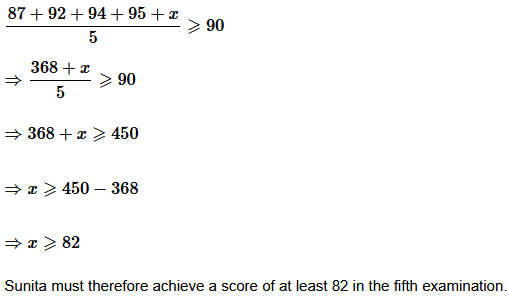
Question 23. Find all pairs of consecutive odd positive integers both of which are smaller than 10 such that their sum is more than 11.
Solution :
Let x and x + 2 be two consecutive odd positive integers.
Let x be the lesser of the two odd positive integers that follow. Then there's x + 2 as the other integer. Because both integers are less than 10 , x+2<10
⇒x<10−2
⇒x<8….(t)
Furthermore, the sum of the two integers exceeds 11.∴x+(x+2)>11
⇒2x+2>11
⇒2x>11−2
⇒2x>9
⇒x>9/2
⇒x>4.5
We get I and (ii) from I and (ii).
Because x is an odd number, the values 5 and 7 can be used.
As a result, the required pairs are (5,7)
and (7,9).
Therefore, the required pairs of odd positive integers are (5, 7) and (7, 9).
Question 24. Find all pairs of consecutive even positive integers, both of which are larger than 5 such that their sum is less than 23.
Solution :
Let be the smaller of the two even positive integers that follow. The other integer is x + 2
because both integers are greater than 5, x>5……(1)
Also, the sum of the two integers is less than 23 x+(x+2)<23
⇒2x+2<23
⇒2x<23−2
⇒2x<21
⇒x<21 / 2
⇒x<10.5……(2)
From (1)
and (2), we obtain 5<x<10.5
Because x is an even number, it can have any of the following values: 6,8, or 10.
As a result, the required pairs are (6,8),(8,10)
and (10,12).
Therefore, the required pairs of even positive integers are (6,8), (8 10) and (10, 12).
Question 25. The longest side of a triangle s 3 times the shortest side and the third side is 2 cm shorter than the longest side. If the perimeter of the triangle is at least 61 cm. Find the minimum length of the shortest side.
Solution :
Determine the length of the triangle's shortest side xcm. Then, length of the longest side =3xcm Length of the third side (3x−2)cm Since the perimeter of the triangle is at least 61cm, xcm+3xcm+(3x−2)cm⩾61cm
⇒7x−2⩾61
⇒7x⩾61+2
⇒7x⩾63
⇒7x / 7⩾63 / 7
⇒x⩾9
As a result, the shortest side's minimal length is 9cm
.
Question 26. A man wants to cut three lengths from a single piece of board of length 91 cm. The second length is to be 3 cm longer than the shortest and the third length is to be twice as long as the shortest. What are the possible lengths of the shortest board if the third piece is to be at least 5 cm longer than the second?
Solution :
The shortest piece's length should be xcm. Then, length of the second piece and the third piece are (x+3)cm and 2xcm respectively. Since the three lengths are to be cut from a single piece of board of length 91cm,
x cm+(x+3) cm+2xcm⩽91cm
⇒4x+3⩽91
⇒4x⩽91−3
⇒4x⩽88
⇒4x / 4⩽88 / 4
⇒x⩽22….(1)
In addition, the third component is at least 5 cm as long as the second. ∴2x⩾(x+3)+5
⇒2x⩾x+8
⇒x⩾8
From (1) and (2), we obtain 8⩽x⩽22
As a result, the smallest board's potential length is larger than or equal to but less than or equal to 22cm
.
